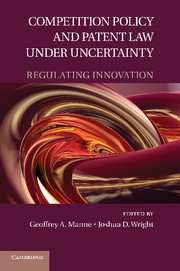Book contents
- Frontmatter
- Contents
- Contributors
- Introduction
- PART I THE INSTITUTIONS OF GROWTH
- PART II THE ECONOMICS OF INNOVATION
- PART III INNOVATION AND COMPETITION POLICY
- 6 Favoring Dynamic over Static Competition
- 7 Antitrust, Multidimensional Competition, and Innovation
- 8 American and European Monopolization Law
- PART IV THE PATENT SYSTEM
- PART V PROPERTY RIGHTS AND THE THEORY OF PATENT LAW
- PART VI INTELLECTUAL PROPRETY AND ANTITRUST: THE REGULATION OF STANDARD-SETTING ORGANIZATIONS
- Index
- References
7 - Antitrust, Multidimensional Competition, and Innovation
Do We Have an Antitrust-Relevant Theory of Competition Now?
Published online by Cambridge University Press: 05 June 2012
- Frontmatter
- Contents
- Contributors
- Introduction
- PART I THE INSTITUTIONS OF GROWTH
- PART II THE ECONOMICS OF INNOVATION
- PART III INNOVATION AND COMPETITION POLICY
- 6 Favoring Dynamic over Static Competition
- 7 Antitrust, Multidimensional Competition, and Innovation
- 8 American and European Monopolization Law
- PART IV THE PATENT SYSTEM
- PART V PROPERTY RIGHTS AND THE THEORY OF PATENT LAW
- PART VI INTELLECTUAL PROPRETY AND ANTITRUST: THE REGULATION OF STANDARD-SETTING ORGANIZATIONS
- Index
- References
Summary
Harold Demsetz once claimed that “economics has no antitrust relevant theory of competition.” Demsetz offered this provocative statement as an introduction to an economic concept with critical implications for the antitrust enterprise: the multidimensional nature of competition. Competition does not take place on a single margin, such as price competition, but several dimensions that are often inversely correlated such that a liability rule deterring one form of competition will result in more of another. This insight has important implications for the current policy debate concerning how to design antitrust liability standards for conduct involving both static product market competition and dynamic innovative activity. The primary purpose of this chapter is to revisit Demsetz's broader challenge to antitrust regulation in the context of the frequently discussed trade-offs between innovation and price competition. I summarize recent developments in our knowledge of the relationship between competition and innovation, highlighting the deficiencies that significantly constrain antitrust enforcers' abilities to confidently calculate inevitable welfare trade-offs. I conclude by discussing policy implications that follow from these limitations.
Introduction
Understanding the complex relationship between competition and innovation is essential to the execution of the antitrust enterprise in our modern economy. The relationship has posed a significant challenge to antitrust economists at least since Joseph Schumpeter's suggestion that dynamic competition would result in “creative destruction” leading to a competitive process where one monopolist would replace another sequentially as new entrants develop a superior product.
- Type
- Chapter
- Information
- Competition Policy and Patent Law under UncertaintyRegulating Innovation, pp. 228 - 251Publisher: Cambridge University PressPrint publication year: 2011
References
- 1
- Cited by



